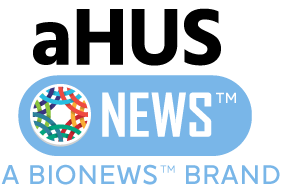aHUS in Children

Atypical hemolytic uremic syndrome (aHUS) can occur during childhood and at any time thereafter. Here is more information about how aHUS may affect children.
What is aHUS?
aHUS is a chronic disease where small blood clots form in multiple organs of the body, especially in the kidneys. The blood clots can lead to a lack of oxygen and nutrients to the organs and result in tissue damage. The blockages, which are caused by activated platelets, also reduce the number of free platelets in the blood, increasing the risk of bleeding and bruising. Red blood cells can also burst when trying to squeeze past the blockages, leading to low levels of red blood cells, or anemia.
How many children have aHUS?
The age of onset of aHUS symptoms may be linked to genetic predisposition and exposure to triggering events such as an infection.
About 1 in 500,000 people in the U.S., or about 900 individuals, are affected by aHUS, with about 20,000 people globally.
According to patient registries, around 42%–47% of cases are diagnosed before age 18, and between 36.3% and 56% of the children are under age 2 when the disease first starts to show symptoms.
What are symptoms of aHUS in children?
Children with aHUS can display a number of different signs and symptoms. A study involving 146 children in Turkey found that 47.6% of the patients had diarrhea as their initial symptom and 24.1% had an upper respiratory tract infection. All of the patients had some form of kidney complication. Nearly half (41.7%) showed complications in other systems of the body outside of the kidneys. The most common system affected outside of the kidneys was the nervous system (28.1%). Children experienced symptoms such as headaches, vision loss, unconsciousness, partial paralysis, hallucinations, and brain damage. The disease also affects the digestive system (10.9%), the heart (6.1%), and the lungs (6.8%).
How is aHUS treated in children?
Medical treatment for aHUS in children is similar to treatment in adults with the first typically being plasma exchange therapy to help slow the progression of symptoms. Many patients may also undergo treatment with Soliris (eculizumab).
What are issues specific to children with aHUS?
Children with aHUS may have additional needs that are different from adults with the disease.
Communication
Young children with aHUS may still be developing language skills and have a hard time communicating their symptoms effectively. This can delay diagnosis and treatment.
Physical activities
The symptoms of aHUS may affect a child’s ability to participate in physical activities, such as sports. Anemia and kidney disease can lead to fatigue, and any lung issues can lead to shortness of breath. Low platelet levels can increase a child’s risk of bleeding and bruising during physical activity. Nervous system involvement, such as seizures and visual problems, can also increase the risks or difficulty of physical activity. Despite these risks, physical activity is important as it can improve a child’s mood as well as provide overall health benefits.
School
If your child has aHUS, inform school staff about it and any treatment or special accommodations that your child may need while at school. You should file a treatment plan with the school and inform teachers of any restrictions. In the U.S., parents can also request a pupil evaluation team meeting to discuss the potential need for an individualized education plan or a 504 plan.
Last updated: Jan. 4, 2021
***
aHUS News is strictly a news and information website about the disease. It does not provide medical advice, diagnosis, or treatment. This content is not intended to be a substitute for professional medical advice, diagnosis, or treatment. Always seek the advice of your physician or other qualified health provider with any questions you may have regarding a medical condition. Never disregard professional medical advice or delay in seeking it because of something you have read on this website.






